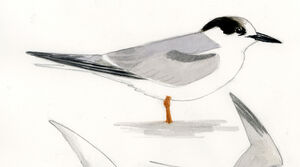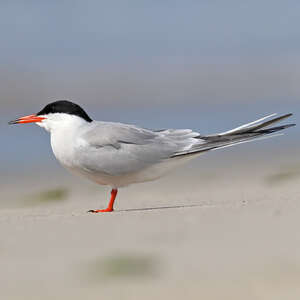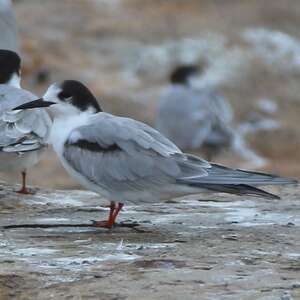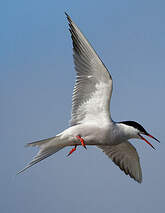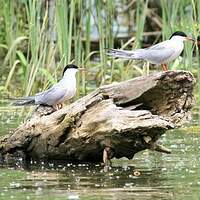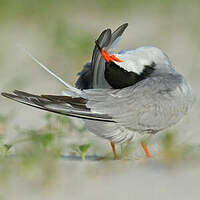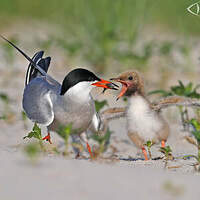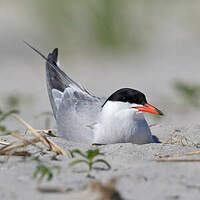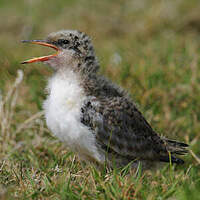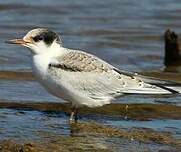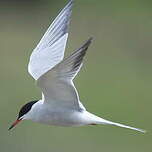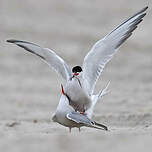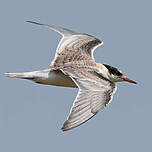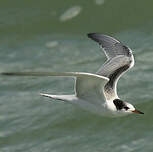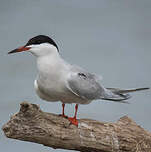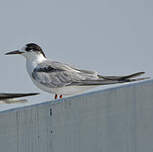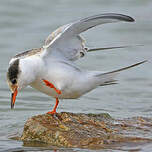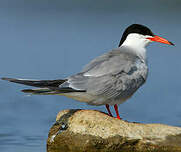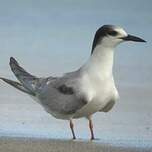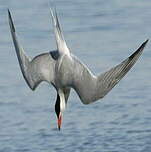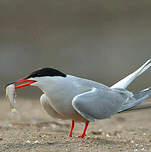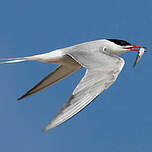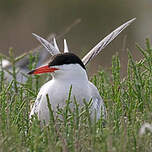Common Tern
Sterna hirundo - Sterne pierregarin
Identification
Seagulls, sometimes called sea swallows, are birds with long wings and graceful flight. Their heads are covered by a black cap, while the rest of their plumage is white and grey, like gulls. The difference between the species of seagulls is quite subtle. You have to look at the beak, the legs, the shape of the tail and the general appearance. The Common Tern has a red beak with a black tip. Its legs are red. Care must be taken not to confuse the Common Tern with the rare Arctic Tern, whose beak is completely blood red and whose tail is longer and more forked. The colour criteria of the beak are only valid when the birds are in their nuptial plumage.
Subspecific information 4 subspecies
- Sterna hirundo hirundo (North America to n South America, n and w Africa, Europe to nw Siberia and w China)
- Sterna hirundo tibetana (w Himalayas to w Mongolia and Tibet)
- Sterna hirundo minussensis (c Siberia to n Mongolia)
- Sterna hirundo longipennis (ne Siberia to ne China)
Foreign names
- Sterne pierregarin,
- Charrán común,
- gaivina-comum,
- Flussseeschwalbe,
- küszvágó csér,
- Visdief,
- Sterna comune,
- fisktärna,
- Makrellterne,
- rybár riečny,
- rybák obecný,
- Fjordterne,
- kalatiira,
- Gewone Seeswael (Gewone Sterretjie),
- xatrac comú,
- Sílaþerna,
- rybitwa rzeczna,
- upes zīriņš,
- navadna čigra,
- Речная крачка,
- Dara-laut biasa,
- アジサシ,
- 普通燕鸥,
- นกนางนวลแกลบธรรมดา,
- 普通燕鷗,
Habitat
Behaviour character trait
The Common Tern is a noisy bird with a graceful and elegant flight. It is a summer visitor (April to September). Its range covers large parts of Europe, Asia and North America, up to the Caribbean, but it is only locally common along the coasts. Inside the European continent it only nests in large numbers on certain natural rivers in France, Italy, Poland and states of the former Soviet Union. It winters at sea off Africa, all the way down to Australia and New Zealand.
Dietfeeding habits
Reproduction nesting
Threats - protection
IUCN conservation status
concern
in the Wild
threatened
evaluated
In the EU, the population of Common Terns shows a positive trend. Modification of the habitat is the main threat. Other problems that add up are colony disturbances, predation and pesticides. In Central Europe, many nesting sites of the Common Tern have been destroyed by river management and water pollution.
Sources of information
- IOC World Bird List (v14.1), Gill, F and D Donsker (Eds). 2023.
Other sources of interest
 Specification sheet created on
28/10/2023 by Didier Collin with help of Georges Olioso
Specification sheet created on
28/10/2023 by Didier Collin with help of Georges OliosoTranslation by AI Oiseaux.net
published: 07-11-2002 - Updated: 28-03-2018
© 1996-2024 Oiseaux.net
- Accipitriformes
- Aegotheliformes
- Anseriformes
- Apodiformes
- Apterygiformes
- Bucerotiformes
- Caprimulgiformes
- Cariamiformes
- Casuariiformes
- Charadriiformes
- Ciconiiformes
- Coliiformes
- Columbiformes
- Coraciiformes
- Cuculiformes
- Eurypygiformes
- Falconiformes
- Galliformes
- Gaviiformes
- Gruiformes
- Leptosomiformes
- Mesitornithiformes
- Musophagiformes
- Nyctibiiformes
- Opisthocomiformes
- Otidiformes
- Passeriformes
- Pelecaniformes
- Phaethontiformes
- Phoenicopteriformes
- Piciformes
- Podargiformes
- Podicipediformes
- Procellariiformes
- Psittaciformes
- Pterocliformes
- Rheiformes
- Sphenisciformes
- Steatornithiformes
- Strigiformes
- Struthioniformes
- Suliformes
- Tinamiformes
- Trogoniformes

